印度脱水泵市场规模预计将从 2024 年的 2.4036 亿美元增至 2031 年的 3.2625 亿美元。预计 2025-2031 年期间该市场的复合年增长率为 4.6%。
印度排水泵市场分析
脱水泵是一种从固体物质或土壤中去除水分的机器或工具。水的分离利用真空或离心力。该泵的种类繁多,从简单的泵到常用于建筑、采矿、废水处理和工业应用的复杂系统,应有尽有。卧式泵和潜水泵等脱水泵用于减少污泥或其他材料中的水分,使处理、处置和后续加工更加高效且经济。脱水泵在减少废物体积和重量、降低运输和处置费用方面发挥着重要作用。它通过确保干燥的工作条件和土壤稳定性,提高了采矿和建筑等行业的运营效率。对节水的重视、污染限值的制定以及对可持续废物管理的关注,正在推动对先进脱水泵的需求增长。此外,城市基础设施的扩张、工业化进程的加快以及对有效废水处理的迫切需求也在推动市场发展。
印度排水泵市场概况
城市化和基础设施建设的增长、采矿业的扩张以及采矿业对脱水泵的日益普及是推动印度脱水泵需求的主要因素。对高性能解决方案日益增长的需求以及各行各业对可持续运营的日益关注,正在推动市场增长。在预测期内,技术进步以及物联网和智能传感器等先进技术在脱水泵中的融合预计将为市场创造丰厚的商机。此外,为增强脱水泵而不断加大的研发力度、对可持续解决方案优势的认识不断提高以及日益增长的环境问题预计将为市场创造未来的增长机会。此外,政府在水处理和污泥管理方面的举措预计将为市场带来新的趋势。
您可以免费定制任何报告,包括本报告的部分内容、国家级分析、Excel 数据包,以及为初创企业和大学提供优惠和折扣
印度排水泵市场:
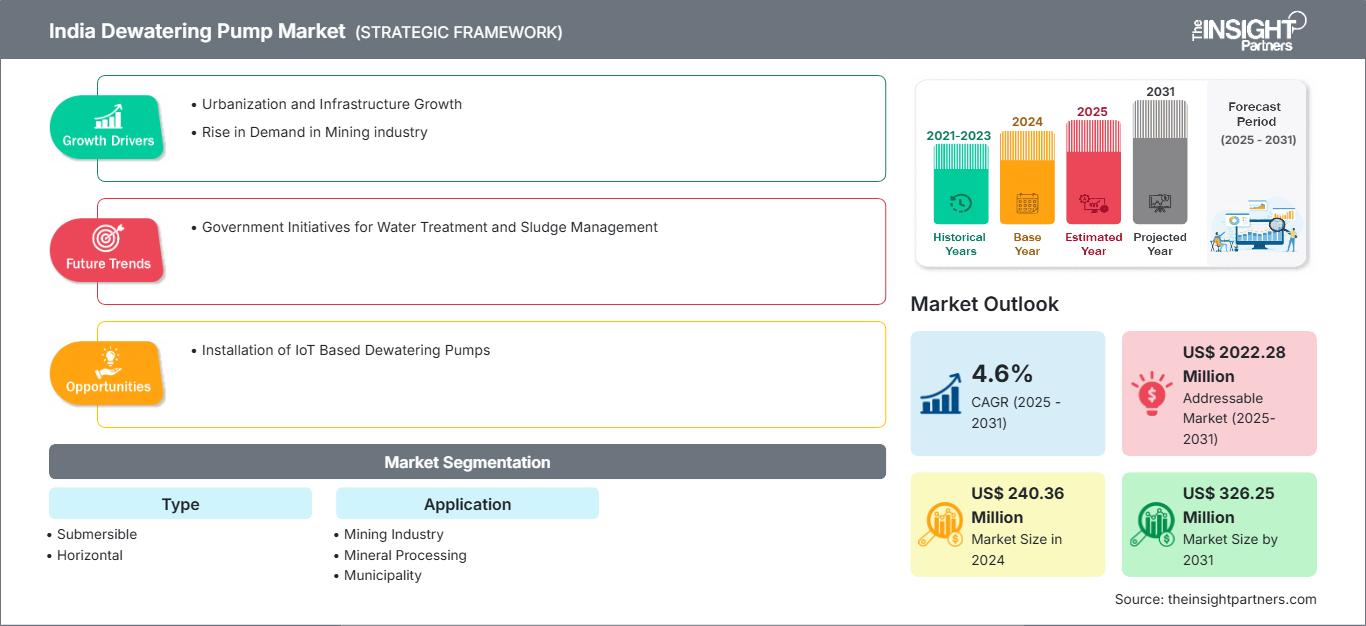
- 获取此报告的顶级关键市场趋势。此免费样品将包括数据分析,从市场趋势到估计和预测。
印度排水泵市场驱动因素和机遇Dewatering Pump Market Drivers and Opportunities
市场驱动因素
快速城市化和工业化
日益增长的建筑和工业活动需要高效的除水系统。严格的环境法规
政府对废水处理的强制要求正在推动各行各业采用脱水技术。dewatering technologies.采矿和矿物加工行业蓬勃发展
脱水对于采矿来说至关重要,可以确保安全和提高运营效率。对清洁水资源的需求不断增长
水资源短缺促使人们通过污泥脱水来重复使用和循环利用水。
市场机会
智能节能脱水解决方案
为了降低运营成本,对自动化、低能耗泵的需求日益增长。二线和三线城市扩张
小城市的基础设施发展为排水系统创造了新的市场。水利项目中的公私合作(PPP)
污水和水处理厂的公私合作为泵的部署开辟了新的途径。与物联网和远程监控集成
先进的技术支持的脱水系统可以提供预测性维护和实时控制。
印度排水泵市场报告细分分析
印度排水泵市场细分为不同的细分市场,以便更清晰地了解其运作方式、增长潜力和最新趋势。以下是大多数行业报告中使用的标准细分方法。
按类型
潜水器
潜水泵的设计使其能够完全浸入水中或泥浆中运行。这使得它们能够有效地从深基坑、矿井、隧道和洪水泛滥的地区排水。水平的
卧式脱水泵是一种通过水平放置从土壤或泥浆中抽取多余水分的技术或机械。
按应用
矿业
脱水泵因其能够提高运营效率同时保持环境合规性而在采矿业中得到广泛应用。矿物加工
在矿物加工领域,脱水泵对于优化资源回收和改善下游操作至关重要。微型企业
安装脱水泵来管理废水和雨水系统,市政当局将受益匪浅。污水处理厂一级和二级处理产生的污泥含水量高,给市政当局的处理、运输和处置带来困难,且成本高昂。其他的
其他垂直行业包括农业、建筑、食品和饮料以及纸浆和造纸。
印度排水泵市场区域洞察
The Insight Partners 的分析师已详尽阐述了预测期内影响印度排水泵市场的区域趋势和因素。本节还讨论了印度排水泵市场在北美、欧洲、亚太、中东和非洲以及南美和中美的细分市场和地域分布。
印度排水泵市场报告范围
| 报告属性 | 细节 |
|---|---|
| 2024年的市场规模 | 2.4036亿美元 |
| 2031年的市场规模 | 3.2625亿美元 |
| 全球复合年增长率(2025-2031) | 4.6% |
| 史料 | 2021-2023 |
| 预测期 | 2025-2031 |
| 涵盖的领域 | 按类型
|
| 覆盖地区和国家 | 印度
|
| 市场领导者和主要公司简介 |
|
印度排水泵市场参与者密度:了解其对业务动态的影响
印度排水泵市场正在快速增长,这得益于终端用户需求的不断增长,而这些需求的驱动因素包括消费者偏好的转变、技术进步以及对产品优势的认知度不断提高。随着需求的增长,企业正在扩展产品线,不断创新以满足消费者需求,并抓住新兴趋势,从而进一步推动市场增长。
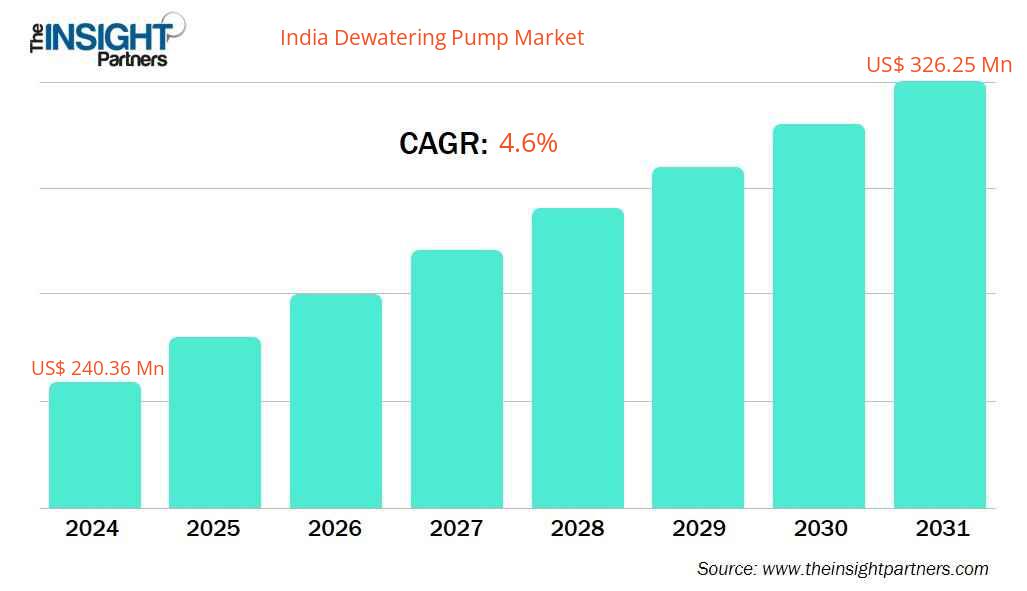
- 获取印度排水泵市场主要参与者概览
印度排水泵市场参与者密度:了解其对业务动态的影响
市场密度高,竞争激烈
由于 Xylem, Inc.、The Weir Group、Atlas Copco 和 Overeign Pumping Solutions 等老牌企业的存在,竞争十分激烈
这种激烈的竞争促使企业通过提供
- 带式压滤机
- 离心机
- 交钥匙脱水解决方案
- 租赁服务
机遇与战略举措
旧系统的更换和现代化为先进的脱水泵提供了机会。
- 脱水技术在农业区地下水管理和排水中的应用越来越广泛。
智慧城市和 AMRUT 等政府计划推动了对脱水泵的长期需求。
印度排水泵市场的主要公司有
赛莱默公司
苏尔寿有限公司
威尔集团
阿特拉斯·科普柯
主权泵送解决方案
Cosmos泵
KPRS泵
基洛斯卡兄弟有限公司
克朗普顿格里夫斯消费电器有限公司
免责声明:以上列出的公司没有按照任何特定顺序排列。
研究过程中分析的其他公司
- 沙克蒂泵业(印度)有限公司
- SB泵
- Arise印度私人有限公司
- 印度泵与压缩机有限公司(BPC)
- ISGEC重型工程有限公司
- 哈里森泵业私人有限公司
- JB泵印度私人有限公司
- Shraddha 泵
- Leakless(印度)工程
- 技术机械工程公司
- 苏加尔工程公司
- Akshat企业
- 萨纳斯工程
- Electrotec 工程师和贸易商
- 联合泵业
印度排水泵市场新闻及最新发展
作为脱水泵解决方案领域的先锋力量,Cosmos Pumps 自豪地推出了“THE GIANT”脱水泵,这是一项尖端创新,有望彻底改变全球采矿业
2024年4月,排水泵解决方案领域的先锋企业Cosmos Pumps隆重推出“THE GIANT”排水泵,这项尖端创新技术势必将彻底改变全球采矿业。该泵拥有650马力,排水能力达每小时1000万升,扬程高达130米。“THE GIANT”旨在解决深层采矿项目中持续存在的渗水和雨水积聚难题。阿特拉斯·科普柯 Power and Flow 已完成其 WEDA 电动潜水排水泵产品组合
2023年7月,阿特拉斯·科普柯动力与流体事业部 (Power and Flow) 完成了其WEDA电动潜水脱水泵产品组合的完善。该系列产品不仅完善了排水和污泥应用系列,还新增了全新的泥浆应用系列,从而实现了全面的产品覆盖。所有型号均按应用场合和处理的流体类型进行分类,简化了从扩展的整个系列中进行选择的过程。Weir 已完成对 Mining Software Holdings Pty Ltd(“Micromine”)的收购
2025年4月,威尔集团完成了对矿业软件控股有限公司(简称“Micromine”)的收购,该收购于今日生效。此前,威尔集团于2025年2月28日宣布,将以6.24亿英镑1(相当于13.1亿美元)的英镑等值企业价值收购全球领先的矿业软件解决方案提供商Micromine。
印度排水泵市场报告覆盖范围和交付成果
《印度排水泵市场规模和预测(2021-2031)》报告对以下领域进行了详细的市场分析
- 印度排水泵市场规模以及涵盖范围之内所有主要细分市场的全球、区域和国家层面的预测
- 印度排水泵市场趋势以及市场动态,如驱动因素、限制因素和关键机遇
- 详细的 PEST 和 SWOT 分析
- 印度排水泵市场分析涵盖主要市场趋势、全球和区域框架、主要参与者、法规和最新市场发展
- 行业格局和竞争分析,涵盖市场集中度、热图分析、知名参与者以及印度排水泵市场的最新发展
- 详细的公司简介
- 历史分析(2 年)、基准年、预测(7 年)及复合年增长率
- PEST 和 SWOT 分析
- 市场规模价值/数量 - 全球、区域、国家
- 行业和竞争格局
- Excel 数据集

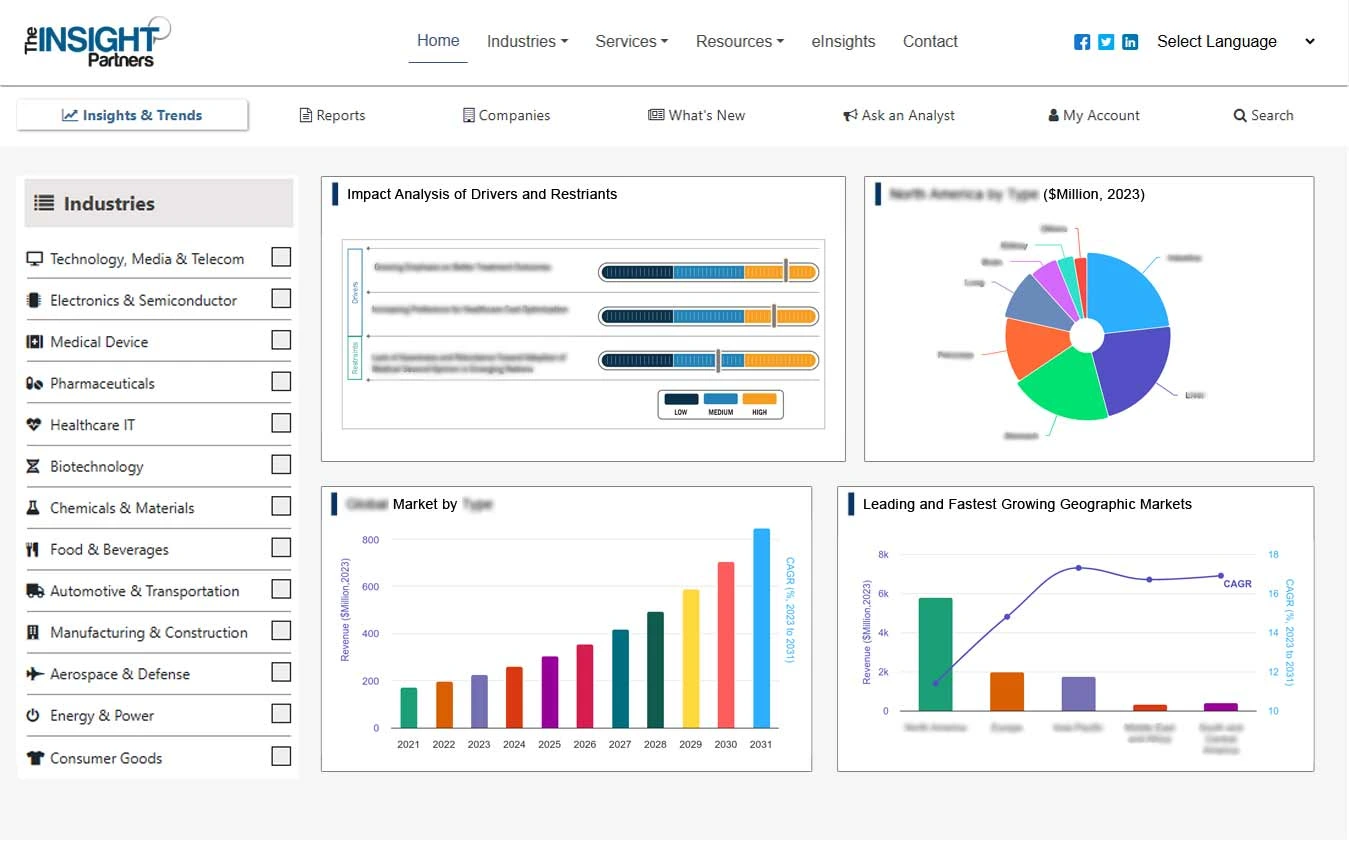

Report Coverage
Revenue forecast, Company Analysis, Industry landscape, Growth factors, and Trends

Segment Covered
This text is related
to segments covered.

Regional Scope
North America, Europe, Asia Pacific, Middle East & Africa, South & Central America

Country Scope
This text is related
to country scope.
常见问题
1. Shift Toward Energy-Efficient and Low-Maintenance Pump
2. Integration of IoT and Automation Technologies
3. Increased Use of Mobile and Modular Dewatering Units
1. Mining Industry now account for ~69% of applications.
2. Mineral Processing—significantly-growing segment (~4.4% CAGR).
The market was valued around US$240.36 million in 2024, projected to reach US$326.25 million by 2031, with a CAGR of 4.6%
1. High Capital and Operating Costs
2. Lack of Skilled Operators and Technicians
3. Inconsistent Power Supply in Remote Areas
1. Rapid Urbanization and Industrialization
2. Stringent Environmental Regulations
3. Growing Mining and Mineral Processing Sectors
The submersibble segment leads, capturing over 80-85% of the market in 2024.
Mining Industry held ~68-70% market share in 2024
Leading firms include :
Xylem Inc., Sulzer Ltd, The Weir Group PLC, KIRLOSKAR BROTHERS LIMITED, Atlas Copco AB, and Sovereign Pumping Solutions, and many region-specific specialists
The List of Companies - India Dewatering Pump Market
- Xylem Inc.
- Sulzer Ltd
- The Weir Group PLC
- KIRLOSKAR BROTHERS LIMITED
- Atlas Copco AB
- Sovereign Pumping Solutions
- Kiwi Pumps
- Cosmos Pumps
- KPR'S PUMPS
- JB Pumps India Pvt. Ltd.
- C.R.I. Pumps Private Limited
- Crompton Greaves Consumer Electricals Ltd
- Vikas Pump
The Insight Partners performs research in 4 major stages: Data Collection & Secondary Research, Primary Research, Data Analysis and Data Triangulation & Final Review.
- Data Collection and Secondary Research:
As a market research and consulting firm operating from a decade, we have published and advised several client across the globe. First step for any study will start with an assessment of currently available data and insights from existing reports. Further, historical and current market information is collected from Investor Presentations, Annual Reports, SEC Filings, etc., and other information related to company’s performance and market positioning are gathered from Paid Databases (Factiva, Hoovers, and Reuters) and various other publications available in public domain.
Several associations trade associates, technical forums, institutes, societies and organization are accessed to gain technical as well as market related insights through their publications such as research papers, blogs and press releases related to the studies are referred to get cues about the market. Further, white papers, journals, magazines, and other news articles published in last 3 years are scrutinized and analyzed to understand the current market trends.
- Primary Research:
The primarily interview analysis comprise of data obtained from industry participants interview and answers to survey questions gathered by in-house primary team.
For primary research, interviews are conducted with industry experts/CEOs/Marketing Managers/VPs/Subject Matter Experts from both demand and supply side to get a 360-degree view of the market. The primary team conducts several interviews based on the complexity of the markets to understand the various market trends and dynamics which makes research more credible and precise.
A typical research interview fulfils the following functions:
- Provides first-hand information on the market size, market trends, growth trends, competitive landscape, and outlook
- Validates and strengthens in-house secondary research findings
- Develops the analysis team’s expertise and market understanding
Primary research involves email interactions and telephone interviews for each market, category, segment, and sub-segment across geographies. The participants who typically take part in such a process include, but are not limited to:
- Industry participants: VPs, business development managers, market intelligence managers and national sales managers
- Outside experts: Valuation experts, research analysts and key opinion leaders specializing in the electronics and semiconductor industry.
Below is the breakup of our primary respondents by company, designation, and region:

Once we receive the confirmation from primary research sources or primary respondents, we finalize the base year market estimation and forecast the data as per the macroeconomic and microeconomic factors assessed during data collection.
- Data Analysis:
Once data is validated through both secondary as well as primary respondents, we finalize the market estimations by hypothesis formulation and factor analysis at regional and country level.
- Macro-Economic Factor Analysis:
We analyse macroeconomic indicators such the gross domestic product (GDP), increase in the demand for goods and services across industries, technological advancement, regional economic growth, governmental policies, the influence of COVID-19, PEST analysis, and other aspects. This analysis aids in setting benchmarks for various nations/regions and approximating market splits. Additionally, the general trend of the aforementioned components aid in determining the market's development possibilities.
- Country Level Data:
Various factors that are especially aligned to the country are taken into account to determine the market size for a certain area and country, including the presence of vendors, such as headquarters and offices, the country's GDP, demand patterns, and industry growth. To comprehend the market dynamics for the nation, a number of growth variables, inhibitors, application areas, and current market trends are researched. The aforementioned elements aid in determining the country's overall market's growth potential.
- Company Profile:
The “Table of Contents” is formulated by listing and analyzing more than 25 - 30 companies operating in the market ecosystem across geographies. However, we profile only 10 companies as a standard practice in our syndicate reports. These 10 companies comprise leading, emerging, and regional players. Nonetheless, our analysis is not restricted to the 10 listed companies, we also analyze other companies present in the market to develop a holistic view and understand the prevailing trends. The “Company Profiles” section in the report covers key facts, business description, products & services, financial information, SWOT analysis, and key developments. The financial information presented is extracted from the annual reports and official documents of the publicly listed companies. Upon collecting the information for the sections of respective companies, we verify them via various primary sources and then compile the data in respective company profiles. The company level information helps us in deriving the base number as well as in forecasting the market size.
- Developing Base Number:
Aggregation of sales statistics (2020-2022) and macro-economic factor, and other secondary and primary research insights are utilized to arrive at base number and related market shares for 2022. The data gaps are identified in this step and relevant market data is analyzed, collected from paid primary interviews or databases. On finalizing the base year market size, forecasts are developed on the basis of macro-economic, industry and market growth factors and company level analysis.
- Data Triangulation and Final Review:
The market findings and base year market size calculations are validated from supply as well as demand side. Demand side validations are based on macro-economic factor analysis and benchmarks for respective regions and countries. In case of supply side validations, revenues of major companies are estimated (in case not available) based on industry benchmark, approximate number of employees, product portfolio, and primary interviews revenues are gathered. Further revenue from target product/service segment is assessed to avoid overshooting of market statistics. In case of heavy deviations between supply and demand side values, all thes steps are repeated to achieve synchronization.
We follow an iterative model, wherein we share our research findings with Subject Matter Experts (SME’s) and Key Opinion Leaders (KOLs) until consensus view of the market is not formulated – this model negates any drastic deviation in the opinions of experts. Only validated and universally acceptable research findings are quoted in our reports.
We have important check points that we use to validate our research findings – which we call – data triangulation, where we validate the information, we generate from secondary sources with primary interviews and then we re-validate with our internal data bases and Subject matter experts. This comprehensive model enables us to deliver high quality, reliable data in shortest possible time.
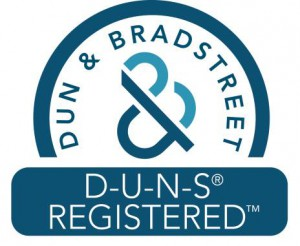
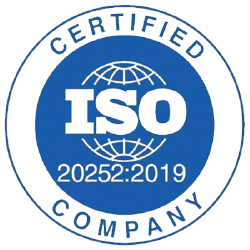

 获取此报告的免费样本
获取此报告的免费样本